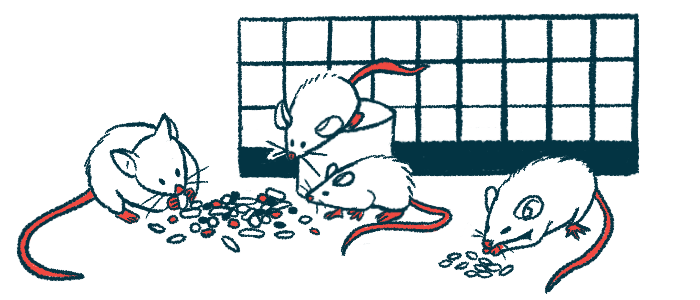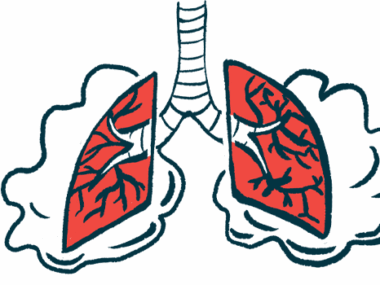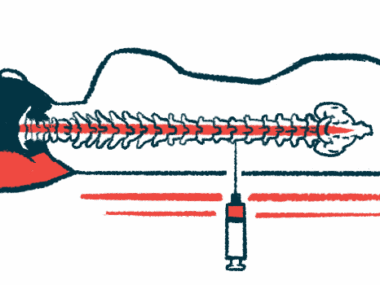Adding BIO101 to Spinraza boosts muscle function in SMA mice
Experimental and approved treatments synergize in combo in lab: Study
Written by |

The experimental therapy BIO101 may help improve muscle strength in people with spinal muscular atrophy (SMA), according to new research done in laboratory models.
“We demonstrated that a daily oral administration of BIO101 can specifically improve muscular function in severe (infanthood) and mild (adulthood) … SMA mouse models,” the scientists wrote.
Additionally, data from experiments in mice suggest that giving BIO101 orally along with the approved SMA treatment Spinraza (nusinersen) can improve muscle resistance to fatigue better than Spinraza alone.
“These results highlight the promising ability of BIO101 to benefit muscular function in combination with [Spinraza],” the researchers wrote.
Their study, “Drug Candidate BIO101 for Spinal Muscular Atrophy as Monotherapy or Combined With the Antisense Oligonucleotide ASO-10-27,” was published in the Journal of Cachexia, Sarcopenia and Muscle. The work was funded by Biophytis, the biotechnology company developing BIO101.
A genetic disorder, SMA is mainly caused by mutations in the gene that encodes SMN, a protein that’s vital for maintaining the health of motor neurons, which are the nerve cells that control movement. Lacking SMN, motor neurons sicken and die, leading to symptoms like muscle weakness and wasting.
Spinraza, sold by Biogen, is an approved SMA therapy that works to boost SMN levels, thus preserving motor neuron health and slowing disease progression. Clinical trials have demonstrated that Spinraza and other SMN-targeting therapies can help people with SMA improve motor function and live longer — though their benefits depend on factors such as therapeutic modality, age, and disease severity, the investigators noted.
BIO101 is a purified formulation of 20-hydroxyecdysone, a plant-derived compound that’s been shown to promote the growth of muscle tissue. It can also increase blood vessel growth and alter metabolism. Biophytis is developing the therapy as a treatment for a variety of different conditions, including obesity and sarcopenia, or progressive, age-related muscle loss.
Using BIO101 alone led to significant gains in SMA mice
In this study, daily treatment with BIO101 was tested in two SMA mouse models. One models severe disease, which usually leads to death within two weeks of birth, while the other models milder disease with motor neuron loss and functional defects developing in adulthood.
In the severe model, treatment with BIO101 alone led to significant improvements in measures of mobility and grip strength, as well as a slight but statistically significant improvement in survival. In the mild model, BIO101 also led to improvements in grip strength in the mice.
The scientists noted that the mouse data showed that BIO101 treatment did not change SMN protein levels. That implies that the therapy is not targeting the root cause of the disease but instead modulates other biological pathways to promote muscle strength, according to the team.
Further tests using muscle cells derived from SMA patients indicated that BIO101 promoted the formation of new muscle fibers and altered cellular energy metabolism. But consistent with the mouse experiments, there was no effect on SMN protein levels.
Building off these observations, the researchers wondered whether BIO101 could be combined with the SMN-targeting therapy Spinraza to achieve a greater effect.
Researchers then combined experimental therapy with Spinraza
Additional experiments in the severe mouse model showed that the combination of BIO101 and Spinraza did not improve survival better than Spinraza alone.
However, mice given both therapies were more mobile than mice given Spinraza only, and the animals performed significantly better on a test that assesses how well they can hang upside down by their paws.
When combined with the SMN-based therapy [Spinraza], BIO101 potentializes motor function improvement, highlighting the therapeutic potential of BIO101 for all severities of SMA.
Overall, the findings suggest that “BIO101 specifically improves resistance to muscular fatigue in combination with SMN-based therapy,” the researchers wrote.
“When combined with the SMN-based therapy [Spinraza], BIO101 potentializes motor function improvement, highlighting the therapeutic potential of BIO101 for all severities of SMA,” the scientists wrote.
Still, the researchers noted a need for additional studies to further explore the safety and efficacy of BIO101 as a potential SMA therapy.
“An optimization of the BIO101 administration frequency could be necessary to enhance the beneficial effect of the molecule in SMA patients but its capacity to mediate different pharmacological effects according to the cellular context and to induce benefits on a wide range of severities and ages, makes it well-adapted to the clinical heterogeneity [variability] of SMA,” the team concluded.








